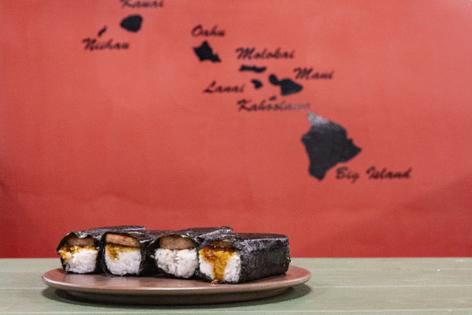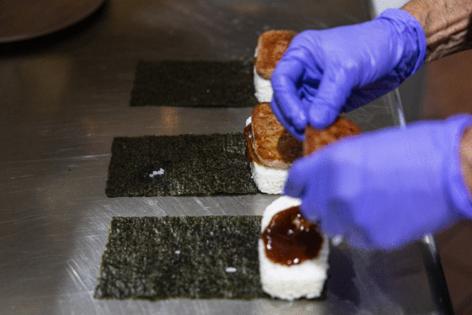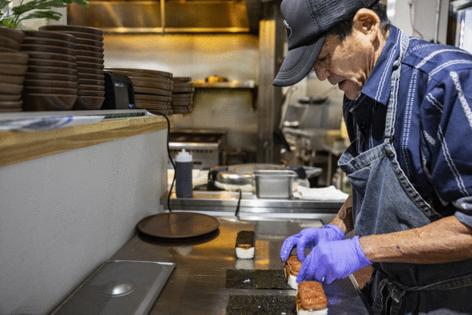Spam is a Minnesota-born meat that's become an essential Asian ingredient
Published in Business News
Jess Kelley, who grew up in Hawaii, can’t remember her first time trying Spam. It was just always there.
Hawaiians eat 7 million cans of Spam a year, more per capita than any other state. Now Spam musubi and other Polynesian and Korean recipes have started changing the cuisine in mainland states, including at Kelley’s Ono Hawaiian Plates.
When Hormel Foods introduced the canned meat in 1937, company leaders did not envision it becoming part of world cuisine. Nor did they think that international flavor would shape one of Minnesota’s most well-known contributions.
After a few West Coast groceries added Spam musubi — cooked Spam on sticky rice wrapped in seaweed — to their sushi sections, the idea took off in the past few years. Now the Hawaiian treat, also a favorite in Japan, is in a thousand stores on the mainland and showing up on restaurant menus, too.
Add to that a permanent new Spam flavor, Korean BBQ, and a limited-time gochujang flavor, and the canned meat is no longer an American cultural export. It’s a global cuisine.
“Spam was born in Austin, Minnesota, but raised around the world,” said PJ Connor, vice president of retail sales at Hormel. “Part of the beauty of Spam is each culture and generation embraces it as their own.”
At Ono, it’s often kids and young adults who are ordering Spam musubi and getting their parents to try it, or friends pressuring friends to try it for the first time, said Kelley, who is co-owner of the restaurant with locations in the North Loop and south Minneapolis.
“They’re like OK, I’ll just have one — then they come back and ask for another one,” Kelley said. “The other day we had a 10-year-old come in and order two Spam musubis and a poke bowl.”
Ono Hawaiian Plates in Minneapolis sells up to 300 Spam musubis every day between its two locations, which co-owner and chef Warren Seta chalks up to increasingly adventurous palates, especially among younger diners.
Kevin Yingling was one of those sales earlier this week.
“You gotta get the Spam musubi,” he said.
Hormel can’t buy better marketing than that.
“We see these ‘Spam-curious’ consumers — if you can get them to try it, they realize it’s really really good,” said Jason Baskin, director of marketing for Spam. “If you’ve never tried Spam, maybe you don’t know what to do with it.”
Over the past few years, Hormel has seen Spam mentions on menus — whether in restaurants, school cafeterias, hotel buffets or other food-service operations — jump 37%.
Spam musubi, Spam and rice, Spam fries, Spam burnt ends. They all help open the door for more Spam sales at grocery stores, the company said.
“That then translates into them becoming Spam fans in a totally different way than just asking them to go down the canned meat aisle,” Connor said.
Seta points out that convenience stores in Hawaii will sell Spam musubi like hot dogs are sold at gas stations on the mainland — the same goes for Spam musubi sold in Japan.
“Instead of getting the hot dog or the nachos, you grab the Spam,” he said.
Spam’s enduring place in Asian and Pacific Island cuisines began with Hormel sending millions of cans a week to Allied soldiers during World War II. Today’s map of the nearly 50 countries with Spam at the grocery store overlaps much of the Pacific theater in that war and the Korean War.
“There’s always been this affinity and excitement for Spam in Hawaii, but over the past few years we’re seeing that excitement coming to the mainland,” Hormel’s Connor said, and that’s largely due to seeing Spam used in new ways.
A retailer that would sell maybe 15 cans of Spam a week started selling dozens of Spam musubis, he said. Other retailers are taking notice.
The Korean influence on Spam is also growing rapidly, especially as K-pop and other elements of South Korean culture become global phenomena. Budae-jjigae, or army stew, mixes Spam and other classic American commodities like sliced cheese and hot dogs with ramen noodles. South Koreans also eat Spam with kimchi, while in China it’s a hotpot favorite, and in the Philippines, it’s commonly cooked with eggs.
Baskin said Hormel is attuned to how Spam shows up in different cultures, and the company will adjust its sales pitch accordingly.
“The biggest difference is we have a dominant market share in the U.S.,” Baskin said. “Internationally, there’s more competition. It’s about reinforcing that consumer belief there is only one Spam, which is seen as a premium product.”
©2024 The Minnesota Star Tribune. Visit at startribune.com. Distributed by Tribune Content Agency, LLC.

















Comments